Decorative
WPC Boards: The Sustainable Alternative to Natural Wood and Plywood
The use of WPC (Wood Plastic Composite) boards as a sustainable substitute for plywood and conventional wood has grown in popularity. One of the main factors contributing to their increasing use is their environmentally benign composition, since the production of WPC boards does not contribute to deforestation.
What are WPC Boards?
Wood powder, additional chemicals, and virgin polymer are combined to create WPC boards. Because of their exceptional strength and longevity, these boards are frequently utilized in the construction industry.
Benefits of WPC Boards
· Termite Resistance: WPC boards are a great option for furniture resistant to termites, making them ideal for indoor and outdoor use.
· Moisture Resistance: WPC boards, in contrast to conventional materials, have a high level of moisture resistance, which makes them perfect for cabinets in kitchens and bathrooms where moisture retention is an issue.
· UV Light Resistance: WPC boards, which come in various colors, are resistant to UV light fading, guaranteeing their endurance in outdoor applications including garden furniture, landscape elements, and facades.
· High Durability: Humidity, chemicals, or rain do not affect WPC boards. They may be installed with standard tools and are simple to deal with.
· Eco-Friendly: WPC boards are 100% recyclable and produce very little waste during production because they are made of biodegradable ingredients. They frequently have a repurchase guarantee and are reusable as well.
· Fire-Retardant: WPC boards are a safer alternative for interior and exterior applications due to their fire-resistant qualities.
· Low Maintenance: WPC boards take less money and effort to maintain because they don’t need to be painted, polished, or sealed. They are a popular option for hectic homes and businesses because they are also simple to maintain and clean.
· Resistance to Corrosion and Decay: When utilized in moist or muggy conditions, WPC boards’ exceptional resistance to corrosion, decay, and fungal attacks prolongs their lifespan.
Disadvantages of WPC Boards
· Appearance: Although WPC boards can resemble real wood, the polish may not be as high-quality as real wood. It’s frequently difficult to imitate the natural grain and feel of wood.
· Temperature Resistance: The limited ability of WPC boards to withstand high temperatures may restrict their use. For example, it is not advisable to place hot utensils directly on them as they may distort when exposed to excessive heat.
· Greater Initial Cost: When compared to other substitute materials like PVC or natural wood, the initial cost of WPC boards may be greater.
· Limited Color Fading Over Time: WPC boards are resistant to fading, although, over time, extended exposure to inclement weather may result in subtle discoloration.
· Not Optimal for Structural Applications: WPC boards are less suited for structural applications like support beams or heavy-duty frameworks because they can’t hold as much weight as genuine wood can.
Exterior Applications
· Swimming pools
· Garden furniture
· Park benches
· Outdoor paneling
· WPC doors
· Planter boxes
· Outdoor deck flooring
· Prefabricated houses
Interior Applications
· Modular kitchens
· Wall paneling
· Wardrobes
· Window and door frames
· Bathroom cabinets
· Railings
· Office furniture
· Industrial sections
Commercial Applications
· Advertising materials
· Signboards
· Exhibition stands
· Graphics and display boards
Conclusion
WPC materials offer durability, eco-friendliness, and a wide range of benefits, making them an innovative choice for sustainable construction. Despite a few disadvantages, WPC boards provide a robust and low-maintenance alternative to traditional wood. As established WPC sheet manufacturers, we offer a variety of sizes and types of WPC boards that are perfect for commercial and residential use. Connect with our experts today to choose the right WPC board for your project.
Frequently Asked Questions
· Q1. What is a WPC sheet?
A. WPC sheets are composite materials made from wood fiber/wood flour and thermoplastic(s) such as polythene (PE), polypropylene (PP), polyvinyl chloride (PVC), or polylactic acid (PLA). They may also contain other ligno-cellulosic and/or inorganic fillers.
· Q2. Which is better: PVC or WPC?
A. WPC is generally more versatile in terms of density and strength compared to PVC, and it is a more cost-effective option. Additionally, WPC is easier to work with for carpentry.
· Q3. Is the WPC sheet waterproof?
A. Yes, WPC sheets are 100% termite-proof, waterproof, borer-proof, fire-retardant, and possess high screw and nail-holding capacity.
· Q4. From where can I buy WPC Board online?
A. You can explore a wide range of WPC products with Decor Odisha, dealing with most trustable brands like Alex, Blackcobra, Mario, Rishta, Austin, Sylvan, Century, and Vivre Panels. Call or WhatsApp at 7992997117.



